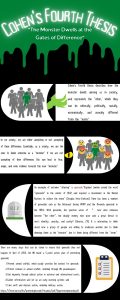10 Genocide: An Extreme Form of Othering
mb1804
Cohen’s Fourth Thesis and its Application to Genocide
Introduction to Cohen’s Fourth Thesis
Cohen’s Fourth Thesis Simplified
In this short video, Cohen’s fourth thesis “The Monster Dwells at the Gates of Difference” is explained with drawn animation.
Cohen’s fourth thesis explains how the “monster” dwells among us in society and that they are the “differences” that don’t fit society’s “norm” in flesh form. Cohen explains that these “monsters” differences can be culturally, racially, economically, politically, and sexually different from what society has accepted and deemed “normal” and that because of that, there are/have been many instances where society reacts to these “monsters” in many different ways such as oppressing them to even the extreme of initiating violence towards them.
Modern Monster: Genocide
As a society, we are all unique and complex. That is what makes us human. And with these differences, it is up to us as a society to be either accepting or not accepting of these differences. Cohen’s fourth thesis, “The Monster Dwells at the Gates of Difference”, explains that the monster dwells among us, and we label them as the “other” whether if they are culturally, politically, racially, economically or sexually “different” from what the “norm” is. If one is not accepting of these differences, then there can be different reactions to these people and their differences such as stereotyping, discrimination and even the heinous act of killing them.
A modern monster that I believe fits well with Cohen’s fourth thesis, “The Monster Dwells at the Gates of Difference”, is the crime of genocide. Genocide essentially an extreme form of “othering”, to which a large group of people is deliberately killed due to their differences. Examples of genocide include the Holocaust in Nazi Germany during WWII and also the Rwanda genocide in the 1990s.
We need to see the warning signs before genocide happens such addressing the hatred and discrimination being spewed by different groups and to take action quickly.
Cohen’s Fourth Thesis and Genocide
 This infographic is an overview of what was mentioned in this chapter.
This infographic is an overview of what was mentioned in this chapter.
Works Cited:
“History of the Holocaust.” Montreal Holocaust Museum, 21 Feb. 2020, museeholocauste.ca/en/history-holocaust/.
Kofi Annan, Kofi. UN Action Plan to Prevent Genocide (Kofi Annan, April 7, 2004) – – Prevent Genocide International, www.preventgenocide.org/prevent/UNdocs/KofiAnnansActionPlantoPreventGenocide7Apr2004.htm.
Manuscripts and Archives Division, The New York Public Library. “Photograph of Raphael Lemkin seated, turned” The New York Public Library Digital Collections. 1947 – 1959. https://digitalcollections.nypl.org/items/25417c90-4aac-0134-2b2f-00505686a51c
Reid, Kathryn. “1994 Rwandan Genocide, Aftermath: Facts, Faqs, and How to Help.” World Vision, 4 June 2020, www.worldvision.org/refugees-news-stories/1994-rwandan-genocide-facts#hutus-tutsis.
“Rwanda, Genocide, Hutu, Tutsi, Mass Execution, Ethnic Cleansing, Massacre, Human Rights, Victim Remembrance, Education, Africa.” United Nations, United Nations, www.un.org/en/preventgenocide/rwanda/.
“United Nations Office on Genocide Prevention and the Responsibility to Protect.” United Nations, United Nations, www.un.org/en/genocideprevention/genocide.shtml.
United States Holocaust Memorial Museum, United States Holocaust Memorial Museum, www.ushmm.org/genocide-prevention/learn-about-genocide-and-other-mass-atrocities/what-is-genocide.
“What Led to the Genocide against the Tutsi in Rwanda?” CMHR, humanrights.ca/story/what-led-genocide-against-tutsi-rwanda#:~:text=The%20genocide%20was%20the%20culmination,of%20the%20Hutu%humanrights.ca/story/what-led-genocide-against-tutsi-rwanda#:~:text=The%20genocide%20was%20the%20culmination,of%20the%20Hutu%20majority%20group.20majority%20group.
